|
1.
CENTRAL/ WEST AFRICA
Log prices holding firm at high levels
The last two weeks showed few price changes for Asian destinations and some price adjustments for European
markets. Overall, log prices for all markets had held firm at high levels. Prices for aiele (African canarium or
abel) made a small gain of euro8 per m3 due to increased demand from China while limba prices lost ground on account of
reduced interest from Chinese buyers. However, prices for limba logs grade B surged euro7 per m3 for Europe. Okan
prices continued to be very firm due to good demand from China and the Netherlands. Some quantities of niangon
logs from Gabon had now re-appeared in the market. Similar reports had been received from Equatorial Guinea.
Heavy rains affect log felling and transport
Heavy rains were seriously affecting logging and transport in Cameron. There were reports of meager amounts of timber coming through from North Congo due to difficult road conditions.
Gabon step up defect control on log exports
In Gabon, authorities stepped up the examination of log exports with more stringent control of measurement of defects and declared volumes. Discrepancies found were being met with fines.
Demand for okoume sawnwood rebounds
Sawn lumber prices also continued to firm with some gains for favoured species such as moabi, movingui and okoume. Okoume lumber was benefiting from better demand and generally increased acceptance in the market. With Italy remaining a regular buyer, producers were
confident of the long-term future for okoume as a substitute for ayous (wawa).
Africa emerges as Asia¡¯s new economic frontier
Chinese and Indian firms are increasingly doing business in Sub-Saharan Africa and their interests in the continent extend well beyond a hunt for natural resources, according to World Bank study ¡°Africa¡¯s Silk Road: China and India¡¯s New Economic Frontier¡±. Exports from Africa to Asia tripled in the last five years, making Asia Africa¡¯s third largest trading partner (27%), on the heels of the EU (32%) and the USA (29%).
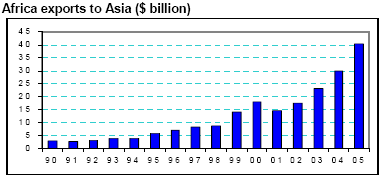
Indian and Chinese foreign direct investment also grew,with China's amounting to $1.18 billion by mid-2006. While growing Asian trade and investment is cause for optimism, Harry Broadman, the study¡¯s author, cautions that there are major asymmetries in the economic relations between the two regions. China¡¯s and India's comparatively high tariffs on Africa¡¯s leading (and highest
value) exports prevent Africa from fully tapping these markets. Africa¡¯s
exports account for only 1.6% of what Asia imports from the rest of the
world.
However, knowledge might end up being India's and China¡¯s greatest gift to
Africa, the Bank says. The knowledge that can be conveyed between Asia and
Africa may turn out to be as or more important than the actual trade and
investment flows. African-Asian trade and investment constitute a very small
part of the solution to the challenges Africa faces, such as lack of
infrastructure and shortage of highly skilled workers. Overcoming these
barriers to economic growth and development may well take decades to be
accomplished.
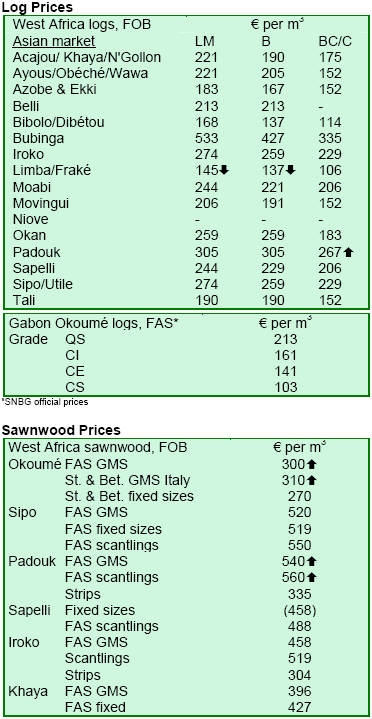
2. GHANA
GTMO urges revision of export levies and taxes
Ghana Timber Millers Organisation (GTMO) had drawn the government's attention to the increasing level of controls being imposed in the forest sector in its efforts to meet international requirements for legal sourcing of timber. GTMO argued that the regulatory measures on
harvesting were constraining the flow of logs to processing mills and thereby increasing the costs of operations. GTMO, therefore, called on the government to review its export levies and taxes to give the industry a competitive edge.
Maxwell Owusu, president of GTMO, said that about 9,000 jobs were lost this year and at least ten companies had closed down since last year because of huge operational costs that included fuel bills, taxes and levies. Mr. Owusu added that many more workers in the industry could lose their jobs by the year-end if the government did not take a second look at the levies and taxes with a view to giving the industry some relief. The situation had been compounded by the recent electricity rationing, resulting from the low water levels in the Akosombo (Volta) Dam, Ghana¡¯s major source of power.
FC reviews log tracking and forest control process
Ghana's Forestry Commission (FC) was reviewing its business process of log tracking and forest control through a series of workshops involving key stakeholders. The process sought to establish a design system to track logs in support of FC¡¯s legal timber programme, which aims at providing assurance to the market on the legality of the source of timber being exported from Ghana. The move was Ghana's response to timber procurement policies being adopted by major markets, particularly the
EU.
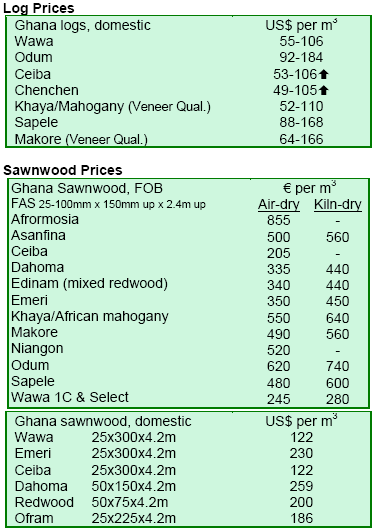
3.
MALAYSIA
Ramadan sets to slow sawmill supply down
Sawmills were expecting a slow down in the supply of logs in coming weeks. This would be as a result of a reduction of harvesting activities during the fasting month of Ramadan which begun on 24 September.
Malaysia expects higher timber earnings in 2006
Malaysia¡¯s export earnings from timber products are expected to surge 5% in 2006, from 5.1 billion ringgit in 2005, on the back of firmer prices and growing demand from traditional markets. Firm prices for plywood and sawn timber and plywood and strong demand from Japan,which accounts for about 50% of the exports, South Korea
(10%) and China (4%) are driving exports up, according to Cheah Kam Huan, senior director of the Malaysian Timber Council
(MTC).
The growing demand is likely to be sustained to next year amid a continuing shortage of supply, added Mr. Cheah after the launch of MTC Wood Wizard (see below).
MTC launches Wood Wizard
MTC recently launched Wood Wizard (WW), an online user-friendly database on Malaysian timbers. WW is intended to help specifiers, architects, designers and contractors search for specific timbers for their projects.
Malaysia adopts new remote sensing technology
The Malaysian Deputy Prime Minister (DPM) and Chairman of the Malaysian National Forestry Council announced that a new remote sensing technology would be used to detect illegal logging and forest fires in the country. It would also provide information on forest
inventory. The new technology will be used by the Malaysian Remote Sensing Centre.
The DPM also announced steps to be taken to streamline policies that would provide incentives to encourage downstream activities to produce higher value-added products, increase efficiency and reduce wastage at existing sawmills.
Prices subject to bullish and bearish effects
Prices of Malaysian timber products remained largely steady through September. Several Malaysian construction companies had announced major housing and development projects that would keep prices of
construction material steady. Developments on several fronts, however, might have bullish or bearish effect on timber prices, depending on the species.
Oil palm fibers, for a long time a major raw material in the production of plywood, might face a short-term to medium-term supply crunch as palm oil consolidates its position as the cheapest feedstock for biodiesel and edible oil, in comparison with soya bean oil and rapeseed oil. The EU had mandated biodiesel usage from its present level of 1% to 5.75% by year 2010.
The same shortage scenario is seen for rubberwood which accounts for 80% of the wooden furniture exported by Malaysia and is an increasing important raw material for plywood and other panel products. Rubberwood supply remains tight even tough natural rubber prices have fallen more than 30% since early July 2006 (see below).
The shortage of raw materials was further compounded by the onset of El Nino, as announced by the US National Oceanic Atmospheric Administration (NOAA), in early September 2006. Drought induced by El Nino might further strain the supply of oil palm fibers and rubberwood as the yield of palm oil and rubber latex may drop, fueling higher prices. This, in turn, would further deter plantation
owners from logging the respective timber.
In contrast, dry conditions would make logging of timber species easier, thereby, driving down the timber prices.
Natural rubber suffers sharp prices fall
World natural rubber prices have fallen more than 30% from $2.55 to $1.77 per kg since 3 July 2006. The sharp fall has been attributed by Malaysia authorities to heavy speculation and manipulation by some market operators. The International Tripartite Rubber Council, formed by the three of the world¡¯s largest rubber producing nations,
Thailand, Malaysia and Indonesia, to maintain and stablise world natural rubber market prices, has announced that mechanisms were being put in place to address further fall in rubber prices in the international market.
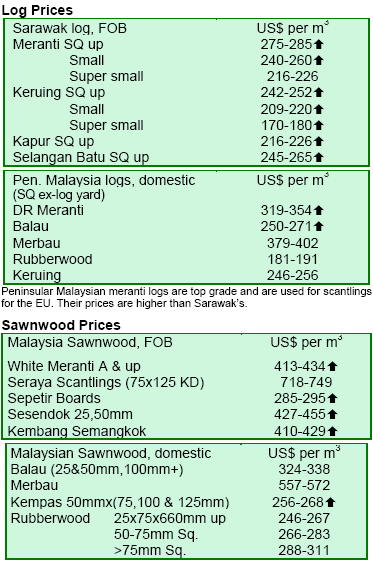
4.
INDONESIA
Domestic prices ease as Ramadan sets in
Business activities in Indonesia, the world's largest Islamic country, slowed down as the Muslim holy month of fasting Ramadan set in. Prices of Indonesian timber
products for domestic consumption registered a slight drop as major construction and development projects around the major cities of Jakarta, Palembang, Medan and Surabaya decelerated during the fasting month. However, prices of export items remained steady.
Cheap rupiah makes Indonesian products attractive
The recent depreciation of the Indonesian rupiah continued to make Indonesia an attractive supplier of timber. Indonesian exporters were keen to maintain their market share in China, Japan, Europe and the Middle-East as the US economy cooled down.
The financial market was also eager with reports that the Central Bank of Indonesia was set to make another cut in its key interest rates by mid-October 2006. This might provide a boost to business activities in Indonesia as the fasting month would end by then.
Efforts to promote investment in plantations failing
Local forestry officials are increasingly frustrated in their efforts to promote forest plantations as investment opportunities to foreign investors. Investors had been showing more interest in the Indonesian banking, oil, gas and telecommunication sectors instead.
Continuing forest fires blanket Brunei
Forest fires continued to rage out of control across Indonesia, blanketing the tiny kingdom of Brunei in the latest development. Threats by the Indonesian government to fine and prosecute offenders had not reduced the problem.
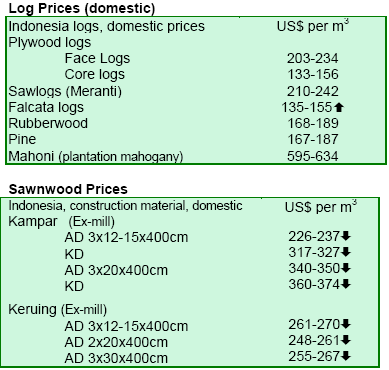
5.
MYANMAR
Veneer qualities teak makes price gains
Teak logs continued to sell well, with prices rising for veneer qualities (2nd to 4th grades) due to smaller volumes available at the sealed tender held on 22 September and the open tender on 25 September. Most of the lots of 2nd, 3rd, 4th and SG-1 grades were mostly bought by European buyers, who had emerged following
the summer holidays.
Prices for SG-2 and SG-4 teak log grades fell in late September. SG-2 fell to average price levels while SG-4 was still higher than May average levels. Prices for other grades had firmed up slightly. According to some analysts, prices were still at peak levels and therefore some automatic price-correction could be expected. But with a
persistent shortage of raw materials, prices were expected to remain high for sometime. The teak market had been resilient to the impact of price fluctuations in the past.
Depots are overstocked ahead of trucking season
Yangon depots are reported to be overstocked with logs. Some analysts estimated the stock at more than 100,000 Hoppus tons of teak logs and 200,000 Hoppus tons of other hardwood logs such as pyinkado and gurjan. With the trucking season coming in November-December,
Yangon depots needed to clear stocks to take in current year's production.
Clarification on closure of Indian factories
In the previous TTM report, it was informed that about 1,000 factories in India accused of smuggling had been closed. The news turned out to be incorrect. New reports indicate the closure of some Indian saw mills due to licensing and some infringements related to illicit use of trees felled from the Indian forests near the eastern border. We regret the inaccuracy of the previous report.
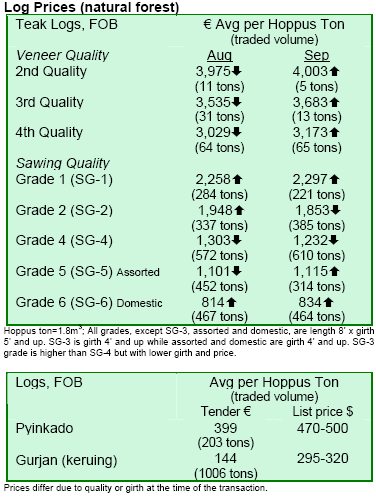
6. PAPUA
NEW GUINEA
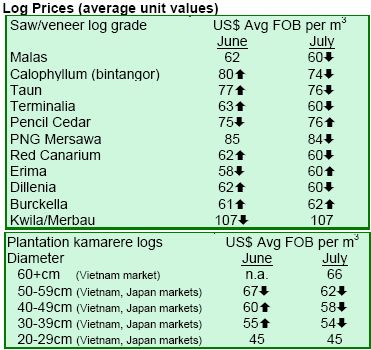
7.
BRAZIL
SEMA resumes approval of FMPs
According to the Mato Grosso¡¯s Secretary of Environment (SEMA), a total of 22 forest management plans (FMPs) had been approved in the Sinop region since SEMA took over the state's environmental management and controlfrom IBAMA last January. These plans authorized
230,000 m³ of timber harvesting. Requests for approval of another 56 FMPs had been submitted to SEMA over the period. The move seemed to be a step towards the normalization of forest operations in the region.
Solid wood products rebound in mixed export results
Brazil's exports of solid wood products rose 9.6% to $378.1 million in August 2006, compared with August 2005. Export of pine sawnwood grew 3.3% to $28.8 million (up 2.7% to 140,400 m³) while those of tropical sawnwood surged 6.9% to $54.4 million (down 8.4% to 146,600 m³). Pine plywood exports increased 5% to $47.7 million (up
7% to 188,300 m³). In contrast, exports of tropical plywood continued to decline, plummeting 41% to 39,100 m3
($25.4 million). Furniture exports also fell 5% to $73.1 million in August 2006.
IADB extends funds to SMES
The Inter-American Development Bank (IADB) has recently launched the ¡°Development Programme of Forest and Wood Processing Productive Chain of the Brazilian Legal Amazon¡±. The programme is developed in
partnership with SEBRAE (the Brazilian Entrepreneurial Agency) and covers small and medium sized enterprises (SMES) in the states of Para and Amazonas. The programme involves an investment of $5 million. Beside investment from SEBRAE and the private sector, the project will have funding from Italian financiers through the Furniture Industry Service Centre
(COSMOB).
According to the IADB's Multilateral Fund of Investments
(FUMIN), the general objective of the programme is to strengthen public-private collaboration in order to generate
better conditions for companies' development, consolidating regional competitiveness of micro, small, and medium companies of the forest sector and the wood processing chain. The main purpose of the programme is to implement an initiative to identify and make public the knowledge and technological solutions for the sustainable development of the productive chain of the forest and wood processing sector in the Northern Brazilian states of
Amazonas and Para.
Amazon chalks lower rate of deforestation
The rate of deforestation in the Brazilian Amazon region slowed 11% to 16,700 km2 in the year to July 2006, down from 18,790 km2 in the previous year, according to the Brazilian Environment Minister Marina Silva. This was the second consecutive year that the pace of the
destruction of the world¡¯s largest tropical rainforests had declined. Booming demand for farm exports had caused land-clearing to peak to 27,500 km2 in 2004. A slowdown in farming-driven deforestation and a crackdown on illegal logging were believed to have contributed to the reduction in the rate. The crackdown included the arrest of IBAMA officers following illegal logging raids.
Some 100 IBAMA employees had been arrested since mid-2003 in raids that had uncovered more than a dozen of illegal logging rings. Recently, police dismantled a group using front companies to harvest timber from protected areas in the western states of Rondonia and Mato Grosso. Seven IBAMA employees were involved.
Brazil proposes fund to slow rainforest destruction
Brazil has proposed establishing a fund to compensate developing countries that slow the destruction of their rainforests, a move that could help lower emissions of gases blamed for rising world temperatures. The Brazilian initiative, presented at a planning meeting for the next round of global climate talks in Rome in November, calls for creating a fund for countries that had brought
deforestation below 1990s rates.
Although most emissions come from oil and coal burning, deforestation is responsible for about 20% of the emissions as stored carbon is released after tree felling. The Clean Development Mechanism allows carbon credit for planting trees where forests have already been cleared but offer no incentives for preventing cutting in areas like
the Amazon. Brazil is working with PNG and Costa Rica which backed an earlier proposal to grant tradable credits to countries that reduce deforestation rates.
SMBC and BoB pen agreement on CDM
Japan's Sumitomo Mitsui Banking Corporation (SMBC) and the Bank of Brazil (BoB) have agreed to cooperate on clean development mechanism (CDM) projects, with the aim of identifying and generating emissions reductions in Brazil and sell the carbon credits to Japanese buyers. The Brazilian carbon market is estimated to generate business
of around $300 million a year.
Under the agreement, the BoB will identify projects in Brazil and introduce the project developers to SMBC and its Brazilian subsidiary Banco Sumitomo Brasileiro. SMBC will then involve Japanese buyer companies in the
process. Japan is the largest buyer of carbon among the countries that signed the Kyoto agreement. Electrical companies are the main carbon credit buyers. Japan needs to reduce carbon emissions by about 615 million tons by 2012.
Forest products exports face stiff competition
The Brazilian agro-business exports reached $21.36 billion in the first semester of 2006, accounting for 35.1% of all Brazilian exports in the period. About $3.44 billion of the total (16.1%) were forest products. The pulp and paper sector alone was responsible for about 56.6% ($1.95 billion) of the total of forest products exported. Soyabean ($4.24 billion) and meat ($3.76 billion) were the major
agricultural products exported in the period. The lower share accounted for by forest products shows the competition difficulties faced by the forestry sector in comparison with agricultural and pasture activities.
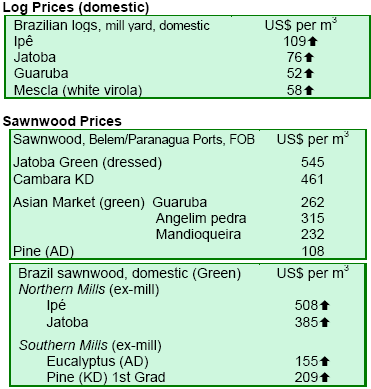
8. PERU
Peru sees steady expansion in spwp exports
In recent years, the world industry has changed a great deal. Fashion (design and style) has established guidelines and paved the way for new products. This global tendency has been influenced by the environment and prices throughout the years, thereby allowing new markets to emerge, such as China and Mexico in the case of the
Peruvian wood industry. Peru exports two types of wood products, namely primary products (sawnwood and uncovered boards) and secondary processed wood products (spwp), which include wood manufactures
(frieses, flooring, handicraft, frames and similar products) and furniture.
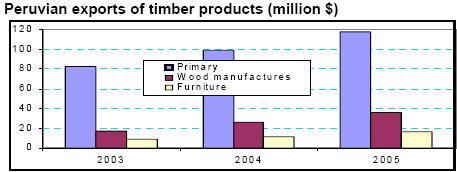
The figure shows that the share of primary wood products of total exports has gradually decreased over the years, from 76% in 2003 to 69% in 2005. These products were mainly of virola (for Mexico) and mahogany (for the USA), which are subject to export quotas (23,621 m3 and 23,239 m3, respectively for 2006). In contrast, exports of
spwp have grown steadily. Exports of hardwood friezes of cumaru, massaranduba, santos mahogany to China, in particular, have influenced this growth. Exports of furniture have comparatively grown more slowly due to the expansion of Chinese exports in key markets.
China is Peru's largest spwp market
Peru main markets for timber products in 2005 were the USA ($69.4 million), Mexico ($55.9 million), China ($25.5 million), Italia ($3.2 million), Dominican Republic ($2.1 million), Spain ($1.12 million) and Sweden ($1 million).
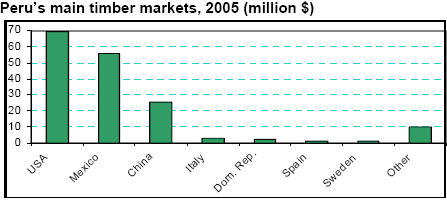
The USA ($56.9 million) and M¨¦xico ($55.9 million) were the main importers of primary products while China ($25.5 million) and the USA ($12.5 million) were the main importers of spwp in 2005. China mainly imported hardwood friezes while the USA imported furniture, tongue and groove flooring and other products such as handicrafts and carved frames.
Contingency plan mooted to address FTA delays
Carlos Bruce, president of the Congressional Commissionfor Foreign Trade, has proposed the government to develop a contingency plan that would allow Peruvian exporters to continue exporting their products to the USA if ratification of the FTA is further delayed by the US
Congress.
Mr. Bruce said the state could assume tariffs costs as credit, which would be reimbursed by exporters after the FTA came into effect. Peru benefits from trade preferences under the Andean Trade Promotion and Drug Eradication Act (ATPDEA) which expires at the end of the year.
Ebbing Amazon hinders Peruvian exports
Peru's National Meteorological and Hydrology Service (SENAMHI) in Loreto warned that the low level of the Amazon River could continue through September. The news had caused concern among Loreto¡¯s population and exporters who depended on river transport for trade and travel.
The lack of rain, caused by the presence of cold and dry air masses from the south and rising temperatures in the Peruvian Andes, where the headwaters of the Amazon were situated, was affecting other towns along the river banks in Peru (Islandia and Santa Rosa), Colombia
(Leticia) and Brazil (Tabatinga). The water level hit a low of 108 metres in August, close to the historic low of 106.5 metres recorded last year.
The shipping of timber products from Loreto to the USA and Mexico had been seriously affected by the low river levels. Some ships had failed to upload timber from Iquitos and other places along the Amazon river, forcing the storage of products in local warehouses. Some Peruvian firms were hiring small vessels to transport their
products to downstream ports in Brazil.
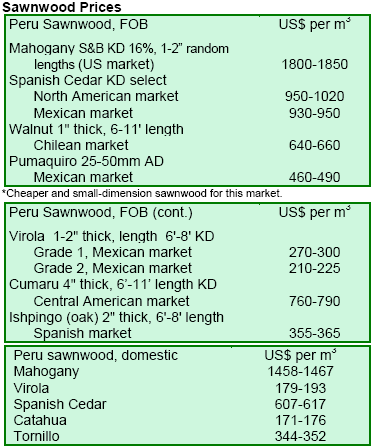
9. BOLIVIA
Bolivia creates credit mechanism to support exports
Bolivia through Supreme Decree No. DS 28855 of 9 September 2006 has established a fiduciary fund for credits for Bolivian exports. The mechanism would be effective from 1 January 2007 in the event that trade preferences under the Andean Trade Promotion and Drug
Eradication Act (ATPDEA) and the Generalized Preferences System (GSP) are not extended next year. The fiduciary fund will amount to $12 million. The contingent credit was created to support Bolivian exports to the USA and ensure that this key market is not lost while a trade agreement is negotiated with that country.
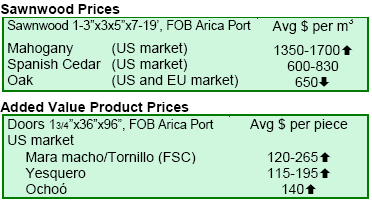
10. Guatemala
Strong demand for teak products pushes prices up
The exports of teak sawnwood accounted for 47% of the total volume of exported teak from Guatemala in Jan-Aug 2006. The price of teak logs and sawnwood rose about $2 per m3 in September due to growing demand from India. Meanwhile, Italy continued to emerge as an alternative
market for Guatemalan teak products. Guatemalan teak suppliers had identified large teak Italian importers. Guatemalan traders were evaluating whether to focus only on the Indian market, according to the Guatemalan Forestry Chamber.
11.
Guyana
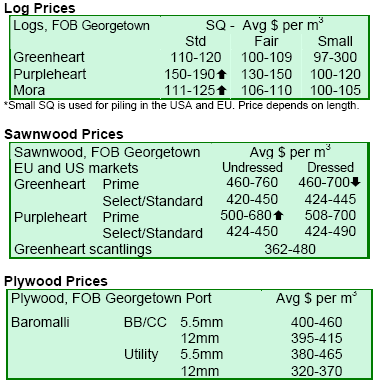
|